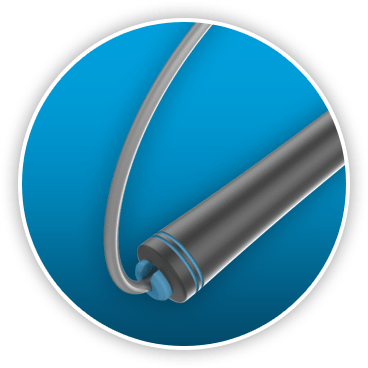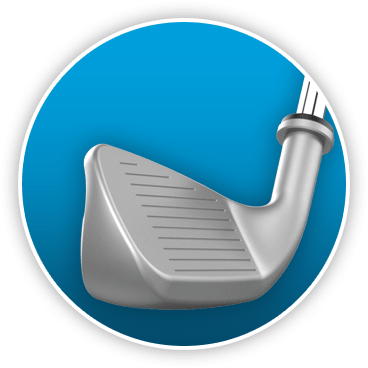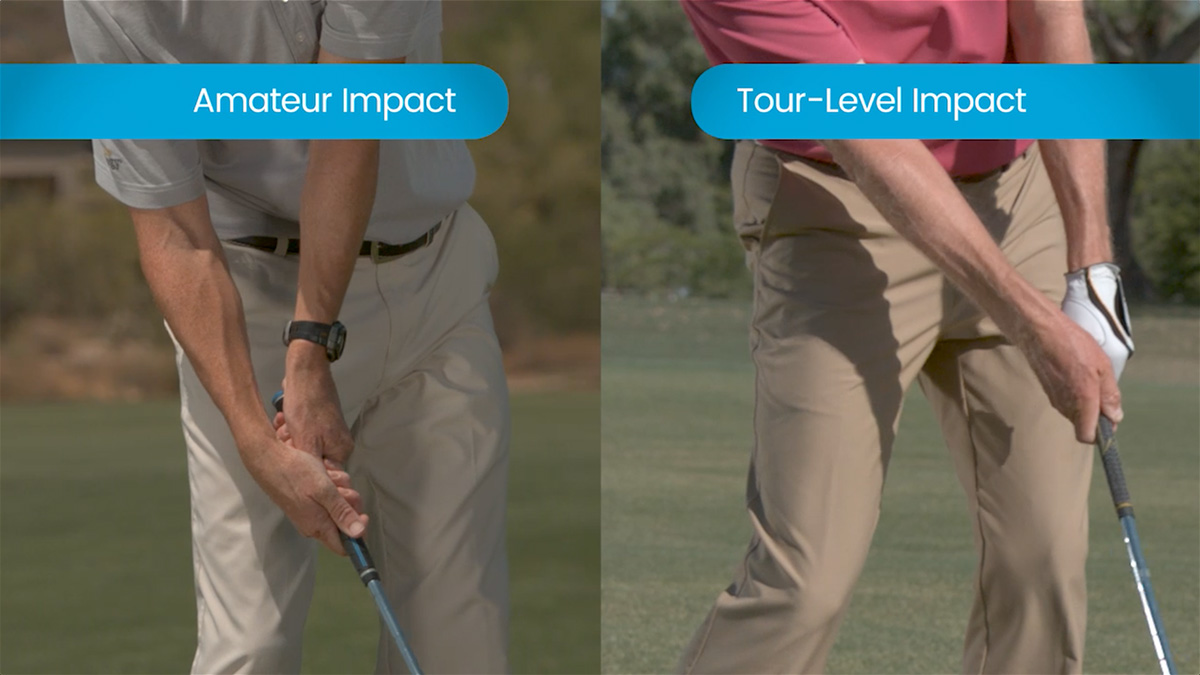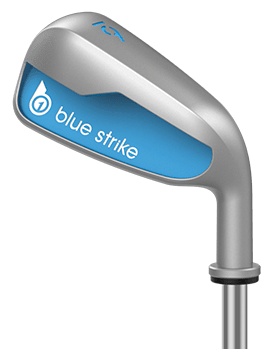
Fix This 1 Small Part of Your Swing (that you may not know is broken) for Tour-Level Impact, Pin-Rattling Accuracy & Unwavering Consistency
Make This Small Change and Add Effortless Distance in a Matter of Minutes
Practically every golfer above a 5 handicap “flips” or “scoops” the club at impact, meaning the clubhead passes the hands too soon. Maybe you flip a little, maybe you flip a lot, but this much is certain: It’s death to your game.

Hello friend,
Think about your typical round or practice session and answer this...
Do your shots make the sound?
Do they turn heads on the range?
Echo across neighboring fairways?
Do they order the wind to stand down with a sharp, “I’m coming through whether you like it or not”?
Do they speak with authority? Command respect? Instill envy… and maybe a touch of fear?
If you’re not sure, then the answer is no.
Your shots don’t make the sound.
And you know what that means.
It means your drives and approaches often come up short.
They sail wide right or veer weakly left.
They get bullied by the slightest breeze and, worst of all, they leave ugly marks on your scorecard.
Let us briefly explain the concept of flipping...
If your release is fundamentally sound, the hands lead the clubhead into the impact area; the left wrist is firm and the clubface square as you strike the ball; after impact, the knuckles turn down to maintain that square face and send the ball rocketing toward the target.
Flipping is pretty much the opposite. The left wrist collapses and the clubhead passes the hands at or before impact; the clubface rotates dramatically from open to closed as the right hand takes over too soon.
The results ain’t pretty.
Puny distance. Fat and thin shots. Slices and hooks. Pushes and pulls.
Or as some folks call it, “Army golf” – left, right, left…
Name a miss-hit and you can trace it back to a faulty release. We’ll explain with more details and images, coming up.
Trust me, you’ll instantly see the difference between a good release and a poor one.
It’s easy to hear, too.
Golfers who make the sound don’t flip.
And golfers who flip don’t make the sound.
Once you start collapsing at impact or flipping the club, it’s incredibly difficult to stop – even if you know you’re doing it.
It seems easy enough to fix, though, right?. Just shift the hands a little forward and voila! Problem solved.
Sadly, no.
The reason you can't stop this shot-wrecking habit—flipping the club—is because even if you can see and hear what you're doing wrong...
If you can’t feel it…
You can’t fix it.
The good news? There's now a fix for your ailing release.
Introducing
The New B1 Blue Strike
The First Training Aid to Ingrain ALL the Elements of a Tour-Level Impact Position (and Fix those Frustrating Flips)
A future of pure shots, lower scores and awestruck buddies is yours for the taking.
The B1 Blue Strike has been proven to work for regular golfers like you. We'll share some of their amazing results – and grateful praise – momentarily.
First, let’s take a closer look at this breakthrough product. As you might expect, we’ve seen countless training aids come and go. Some work pretty well. A few work genuine wonders.
But we’ve never seen one quite like the B1 Blue Strike.
Simply put, it’s the best tool in golf for grooving a powerful, hands-ahead impact position with a flat left wrist, just like the pros’ – the secret to superior ball-striking.
Oh, by the way: The B1 Blue Strike also teaches you to “lag” the club for maximum distance while honing your timing down to the nanosecond.
The great thing about the B1 – well, one of the great things – is that you can practice by hitting balls with it or just swinging it… wherever you happen to be.
Either way, you’ll get a wealth of instant, actionable feedback – the key to quick and lasting improvement.
Let’s examine the three key features that make the B1 so remarkably effective:

The Impact Bow
A thin, flexible cable looping from the top of the shaft to the top of the grip, the Impact Bow is ingeniously simple.
Just keep it touching your left wrist through the hitting area until you reach waist-high in the follow-through, and you’ll know you’ve released the club properly.
If the Impact Bow separates from your wrist in this zone, it means you’ve flipped it.
Once you’ve learned to do it right consistently, the bow won’t be your only signal. You’ll see it, hear it and feel it in your shots.
The Impact Bow is also retractable, so you can hit balls without using it.

The Anti-Flip Compression Sole
This feature reinforces the hands-ahead position by making you pay for flipping.
The B1’s leading edge is beveled at a slight angle, raising the clubface above the ground. If your hands lead at impact, you’ll strike the ball with a solid, downward blow and a square clubface.
If not, the B1 will either bottom out before contact or you’ll catch the ball thin.
In other words, you can’t cheat this sole.

The Impact Slider
In addition to all the info from the Impact Bow and Anti-Flip Compression Sole, the Blue Strike provides auditory feedback as well.
The Impact Slider is attached to an o-ring just below the B1’s grip and slides toward the clubhead as you swing down. Time your release just right and you’ll hear the slider hit bottom at the moment of impact. Release even a fraction early and the slider will go “whack” too soon.
The Impact Slider not only helps you square the clubface, it promotes the delayed release action called “lag” – a power move shared by all pros and many high-level amateurs.
Those are the Blue Strike’s features.
Now for the benefits.
We’ll start with the basics because it’s a really long list.
By practicing with the B1 Blue Strike and transforming your flips into an effortless, flat-lead-wrist release, you’ll enjoy:
We’ll expand on all of this as we move along.
But we can’t wait another second before showing you…
We Put the B1 to the Test - Undeniable Proof of the B1 Blue Strike’s Flip-Fixing, Game-Changing Capabilities.

The trials involved 19 golfers representing a wide range of skill levels and handicaps – from 8 to 26, with an average of 15.5.
Each golfer hit a series of shots with his own 6-iron, then worked for 5 to 10 minutes with the B1 Blue Strike before returning to his 6-iron. A state-of-the-art TrackMan launch monitor collected key data while multiple cameras captured the action.
The goal: To find out if the B1 could improve a golfer’s release and ball-striking in a matter of minutes.
That’s no small task. It can take weeks (if not months) to make even minimal progress with old-fashioned lessons and practice.
Clearly, time was not on the Blue Strike’s side.
And we won’t waste yours with a big, suspenseful build-up. You wouldn't be reading this if the B1 had bombed.
So let's jump right to the best parts – starting with Robert VanDamme.
After just 11 shots with the Blue Strike, Robert’s full 6-iron swings produced a longer average carry distance, total distance and higher “smash factor” (which measures ball-striking efficiency) than his “before” swings.
In addition, Robert reversed his swing path from outside-in (fade) to inside-out (draw) while lowering his launch angle – in his case, a very good thing.
The data spoke volumes about Robert’s rapid progress.
But the sound spoke even louder.
“After hitting with the Blue Strike,” Robert marveled, “I started sounding like a tour pro.”
Remember, this happened in mere minutes. Robert barely had time to try out his new release – let alone master it.
And his experience was hardly unique. Many testers swung slightly slower after trying the Blue Strike, but gained yards through improved contact and compression. (We can only imagine what they’ll achieve once they really get the hang of it.)
Standouts included 13 handicapper Ryan Spiekerman, who increased his carry distance by 11.1 yards thanks to a higher smash factor.
“In 10 minutes,” Ryan beamed, “I was able to correct a problem that I've had as long as I can remember.”
Bill Novak, a 12, got a B1 boost in total distance (up 5.1 yards), plus a lower launch angle and better smash factor. (Cool stat: His 1.42 smash beat the PGA Tour average for a 6-iron.)
Bob Albright, whose 8 handicap was the lowest of the bunch, used the Blue Strike before stinging a 6-iron 181 yards – 13 yards farther than his best before the B1.
We could keep throwing numbers at you – believe me, there are plenty that back up the Blue Strike’s effectiveness – but the golfers’ comments paint a clearer picture...

“After 10, 15 minutes, I was hitting the ball 10, 20 yards farther, and swinging easier. That's a good thing for me, because I don't need to be swinging as hard as I did when I was 20. I was hitting the ball much more consistently, with a nice trajectory and within three yards of either side of the target.”
Scott McGuffin | 12 handicap
“Using the Blue Strike for 10 minutes, and then going back to my iron, it's like night and day. The Blue Strike helped the quality of my shot. It helped on impact. It kept that ball straight and that's what I'm looking for. The consistency was definitely there with the Blue Strike.”
Bob Thadeus | 17 handicap


“The Blue Strike really helps me get more consistent with my shots. The distance with the 7-iron was considerably better. It just felt better, too. It was a nice, clean hit. I'm impressed with the Blue Strike.”
Den Komaromi | 26 handicap
“By keeping the Impact Bow up against my wrist, I could tell when it was separating from there instantly so it was a mental reminder right off the bat. After the Blue Strike my swing slowed down considerably and the ball would jump off the face. It was dead on target every time, and that was straight down the fairway. I didn't have to plan for corrections.”
Bob Albright | 8 handicap


“It's real simple to grasp what (the B1) will teach you to do, and then it's just getting your muscles to do that. You get the immediate response of, ‘I’ve got it right’ or ‘I don't have it right.’ Understand that I'm no spring chicken, I've been doing it my way for 55 years or so. I'm an old dog, but I can learn new tricks, and this one is easy to learn.”
Jim White | 9 handicap
“I've never hit down on the ball with my hands ahead. I've always been afraid to do that, but this gave me the confidence to do that. For me to hit an iron with a draw is rare, (but) I hit several with the Blue Strike. I'm impressed. Bottom line, I think the Blue Strike is a great training aid.”
Bill Novak | 12 handicap


“It really had a good effect in terms of making sure that I didn't flip the club as much as I tend to do. The Blue Strike helped me with my driver as well, and interestingly, even though it does keep the shaft leaning forward going through, I seemed to hit it higher than I normally do.”
John Valiante | 13 handicap
“After I took a few practice swings with the Blue Strike and I started to get the feel for it, I was hitting all of them much more consistently. The Blue Strike has helped me more than anything else I have tried thus far, including lessons. I will definitely recommend it to anybody who might be on the fence. The Blue Strike really is an amazing training aid.”
Jose Gonzalez | 20 handicap


“I looked at the video of the before shot, and I… was slapping at the ball. When I watched (video of my release) after using the Blue Strike, it was unbelievable. The difference was night and day. I came through the ball the way you're supposed to come through the ball. This is the best thing that's ever happened to my golf game.”
Marc Fortunato | 21 handicap
“After training with the Blue Strike for no more than 30 minutes, my last five drives were about 40 yards further than my average and they felt good. Not only were they long, they were on target. Less than seven yards off target at 300 yards, if I remember correctly, and I can play golf with that.”
Michael McAndrews | 18 handicap


“After hitting with the Blue Strike, just the impact, the sound, and watching the shot was pretty impressive. It made me realize that I could be more consistent on the golf course potentially.”
Patrick Walker | 17 handicap
“The Blue Strike club's design is so simple, and the feedback is immediate. You know exactly when you have the club in your hand what you're supposed to do with it. You don't have to guess. I know when I address the ball if I'm doing it right, and if I'm doing it right at the address, as the Blue Strike shows, then I'm going to hit the ball better.”
Richard Carroll | 18 handicap


“This is the fastest I’ve improved in a short amount of time. I’ve done lessons, I’ve read books, I’ve seen videos… This is the fastest.”
Robert VanDamme | 16 handicap
Here is a Look at These Amateurs Fixing Major Swing Problems in Just Minutes with the B1 Blue Strike
Still here? We get it. When making a purchase decision, there’s no such thing as too much information.
Let’s proceed.
Any golf instructor worth half his weight will tell you that collapsing at impact is like any bad habit – easy to develop, hard as heck to break.
But why do so many golfers become flippers in the first place?
Blame it on the brain.
While we’ve all heard the mantra “Hit down to make the ball go up,” the idea is counterintuitive.
Instead, golfers instinctively try to lift the ball into the air by – you got it – scooping with the club at impact.
Let’s look at the difference between a pro’s release and the typical amateur’s.

First the pro's
1. The hands lead the clubhead through the hitting area, so the shaft leans toward the target. 2. At impact, the left wrist is flat and pointed at the target. 3. The clubhead is moving downward as it strikes the ball; the clubface is square. 4. After impact, the right hand rolls over the left, with the knuckles turning toward the ground on the follow-through.
Now for the amateur:
1. The left wrist collapses into a “cupped” position while the right hand “flips” underneath, so there’s no forward shaft lean. 2. The clubhead passes the hands at or before impact. 3. The clubhead is moving parallel to the ground, if not slightly upward, as it strikes the ball. 4. The left wrist remains hinged while the back of the right hand points down during the follow-through.
The contrast is obvious in slo-mo and still photos, but very hard to spot (or feel) at full speed. Even with lessons and practice, grooving the correct motion can be a painstaking process.
You can watch videos of your impact position vs. a pro’s…
Get hands-on instruction from dawn till dusk…
Have drills and a step-by-step practice plan…
And, even with all this at your disposal, revert to your old, improper release because...
If you can’t feel it, you can’t fix it.
And that’s what makes the B1 Blue Strike such a valuable tool. It teaches you exactly what the correct impact position feels like.
In the interest of full disclosure, we'll tell you that many of our test golfers found the B1 a bit awkward at first.
No surprise there. When your arms, wrists and hands have developed a flipping or scooping action, doing it right is bound to seem wrong.
Of course, they quickly realized that the Blue Strike way is the only way to go.
All it took was the sensation, the sight and, yes, the sound of that first perfect shot.
Marc Fortunato, a 21 handicapper, stands as Exhibit-A.
On previous trips to the driving range, Marc explained, “I would get a few shots where I said, ‘Wow, that shot feels like what I think it's supposed to feel like.’ Nothing like this…
“This was 15 straight shots that just feel like a golf shot is supposed to feel.”
That feeling, like the sound, is more than a sweet sensation.
It’s indisputable evidence that your release is spot-on.
Imagine that – barking commands at your ball and having it actually listen.
That’s the future that awaits you with the B1 Blue Strike.
If you’ve seen, read and heard enough to realize this incomparable training aid is exactly what your swing needs, there’s no point sticking around. All you do is:
So you’re holding out for even more info.
No problem. I’ve got you covered.
First, let's sum up the differences between a poor impact position and a good one. In other words, what you’re getting now vs. what you’ll get from practicing with the B1 Blue Strike.
It’s all in this chart:
B1 Blue Strike: A World of Difference
You do want to play better golf, right?
OK, good. I’m glad we’re on the same page.
But just to be absolutely sure you’ve got all the info you need, let me answer a few questions you may be asking.
B1 Blue Strike Q&A
(Yes, Your Improvement Will Translate to the Driver)

Q: I understand the concept of flipping, but how can I tell if I’m doing it?
A: We mentioned before that if you’re above a 5 handicap, flipping, scooping or collapsing the lead wrist at impact is a near certainty. But we suggest having a friend take a slo-mo video of your swing – most smartphones have this capability – then comparing your release to the correct method in the images above.
The key thing to look for is the position of your left (lead) wrist at impact. If it’s cupped (as opposed to flat or slightly bowed), that’s a flip. Also, if you’re hitting an iron and the shaft is perpendicular to the ground or leaning away from the target, that’s definitely a flip.
And you need the B1 Blue Strike.

Q: You talk about “de-lofting” the club for a lower ball flight, but isn’t the goal to hit the ball as high as possible?
A: We're glad you asked, because that’s a common misperception.
While it’s true that many amateurs need more height – especially on their drives – hitting high iron shots is usually a sign of flipping.
A properly struck shot takes off like a bullet, cuts through the wind, rises to an apex and drops abruptly with tons of backspin.
A flipped shot, even when hit solidly, goes straight up in the air, gets knocked around by the wind and rolls after landing. When you miss-time the flip, you’ll hit it fat or thin, left or right.
Still not convinced a lower trajectory is preferable? Consider: A standard 6-iron features 26° – 28° loft, yet TrackMan finds the typical pro golfer launches it at only 14.1°… about half the club’s loft. Same goes for the other irons.
Most ams launch their 6-irons between 18° – 25°.

Q: The B1 Blue Strike sounds perfect for honing my irons and hybrids. But will I see the same benefits with my driver?
A: Totally fair question, and we’ll answer before explaining:
Yes, indeed – no doubt about it.
While we’ve told you how the B1 ingrains a downward impact motion, you’ve been taught to hit up on the driver.
So it stands to reason that using the Blue Strike wouldn’t help your tee shots.
There are two reasons it does:
Ball position and tee height.
With irons and hybrids, you play the ball between your left instep and the middle of your stance, right? (If not, you should.) This encourages a descending, hands-ahead strike because the ball is slightly behind the bottom of your swing.
Presumably, you tee up the driver with half the ball above the clubface and opposite your left instep. From here, you’ll naturally catch it as your arc bottoms out, or just after.
In short, the release for all clubs is the same. The position of the ball makes the difference.
OK, that wraps up our Q&A session.
By now, we hope we’ve made one thing very clear:
To play the best golf you can play, grooving a proper release is an absolute MUST. And the quickest, most effective way to do that is by using the B1 Blue Strike. Period.
It’s also the most cost-effective.
Trust me, you’d pay a pretty penny for all the lessons needed to cure the flips and install a sound release in their place.
I’m thinking $300, minimum.
Add a few hundred bucks more for the range balls you’d go through – many of them wasted during a frustrating trial-and-error process.
Worst of all? You could spend all that money, and time, and end up no better than when you started.
Thank goodness there’s finally an alternative.
For a Limited Time Only, Through this Special Offer…
You'll pay only $129.
Yep, just 129 bucks.
That’s all you’ll pay for the game-changing B1 Blue Strike. And it comes with a 60-day, try-it-all-you-want, money-back guarantee.
If the B1 Blue Strike doesn’t improve your ball-striking, distance, accuracy and consistency within 60 days, you’ll get your money back. Guaranteed.

Please note, we're not promising overnight success.
The B1 Blue Strike takes a little getting used to because it forces you to do the opposite of what you’ve always done.
As 9-handicapper Jim White said, “It's not something you're gonna learn in 30 minutes after you've been doing it the other way for 50 years.”
But if you’ll dedicate yourself to working with the B1 regularly, for a few minutes at a time…
On the range or the back yard, indoors or out…
Hitting balls or just using the Impact Bow, Anti-Flip Compression Sole and Impact Slider…
And practicing with your normal clubs to get the motion down pat…
We guarantee you’ll see major improvement within 60 days. If not, you’ll get a full refund (minus shipping & handling fees).
PLUS… Purchase the Blue Strike today and you’ll also get:
Free B1 Blue Strike Bonus Series
Fix your impact right from your takeaway



In this three-part video series, Clay tackles one of the most common problems among amateur golfers...
This single issue can cause nearly any miss-hit in the book, from slicing to topping to weak distance. Watch these videos, practice the recommended drills and soon you will:
Order today and get my discount...
Just to be up front, I'll earn a small percentage on any purchase you make. This helps me keep the lights on and continue making great content for you.


Regular Price:
$169.00
'CLAY'
DISCOUNT
$
OFF
Your Price with Clay's discount:
$129 USD
+ shipping - add to cart to see cost by location
+ For orders shipped outside the U.S., you are responsible for any import duties / tariffs.

100% Secure Checkout and 60-day, try-it-all-you-want, money-back guarantee.
© 2015-2024 TopSpeedGolf.com TopSpeedGolf.com | Terms of Use | Privacy Policy